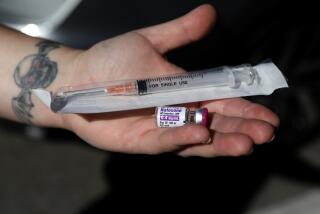Medications Found to Block Cocaine Effects
- Share via
A small but growing number of physicians around the country are finding that even the most severely addicted cocaine users can be treated successfully with medications that either block the craving for cocaine or block the euphoria normally produced by it, much as methadone blocks the effects of heroin.
Unlike methadone, however, these prescription drugs are not addictive and can be given on an outpatient basis.
All of them are sold for other purposes, such as to combat depression, correct menstrual abnormalities and prevent influenza. And now the unforeseen uses of such drugs have sent neuroscientists back to their laboratories to conduct animal studies to determine more precisely how the drugs work in humans.
Unusual Order of Events
This is an unusual sequence of events because new drugs are widely tested in animals before they are used in humans. But once a drug is approved by the U.S. Food and Drug Administration, nothing prohibits a physician from prescribing it for any use.
In the emerging human experiments, several new studies have shown that the drugs can help up to 75% of cocaine addicts get free from drug use. That is about the same success rate that is typically achieved by detoxification in hospitals.
But the new drugs have been slow to be accepted by most large hospitals and clinics that offer drug detoxification, at least in part because of the attitude that treating drug addiction with another drug may send the wrong message to the abuser.
Nonetheless, a consensus is beginning to emerge that the new medications will be more widely used as cheaper and more addictive forms of cocaine--called “crack” in the East and “rock” in the West--become more widely available.
Highs More Intense
Rock is normally smoked and the drug reaches the brain much more quickly than when cocaine is snorted into the nose. Highs produced by rock are generally more intense, and addiction produced by it is generally harder to treat--a fact that may ensure wider use of the medications.
The use of the such drugs to treat cocaine addiction is based on the increasing knowledge of cocaine’s effects on the body, which include chronic cough, chest congestion, impotence, infertility, lactation in women and enlarged breasts in men, brain seizures and cardiac arrest.
For the cocaine users, however, the most important of these effects is the euphoria created by disruption of communication between brain cells, which interact by means of chemical messengers called neurotransmitters.
Dual Reaction
After a brain cell receives a chemical message, it sends the neurotransmitter back so that it can be used again. Most investigators now think that cocaine both stimulates the synthesis of neurotransmitters--particularly one called dopamine--and blocks their return.
Dopamine and other neurotransmitters then accumulate in abnormally high quantities at the receiving cells, flooding and over-stimulating them. This flooding is thought to produce the euphoria associated with cocaine use.
Because of the overproduction of neurotransmitters, however, the brain eventually runs out of the chemicals from which they are made. The cocaine users then become depressed and develops a strong craving for cocaine. If they get high again, the depletion of neurotransmitters is increased and the craving and depression are worse the next time the users come down.
Many researchers now believe that this process can be short-circuited by the use of drugs that either block the receptors where neurotransmitters such as dopamine normally bind or stimulate the increased synthesis of neurotransmitters.
Treating Addicts
Psychiatrist Jeffrey Rosecan, director of the Cocaine Abuse Treatment Program at Columbia-Presbyterian Medical Center in New York, for example, has been treating cocaine addicts with the antidepressant imipramine, which is known by the trade name Tofranil.
Rosecan accidentally discovered the effect of imipramine while treating patients for cocaine-related depression. When two of his patients taking the antidepressant discovered that they could no longer get high on cocaine, Rosecan recalled, “I knew then that I was on to something.”
Imipramine, he said, apparently binds to the same sites in the brain that cocaine binds to, and thereby blocks its action. Rosecan has now treated about 250 patients with imipramine with a success rate of about 75%. “The drug is quite effective for crack addiction,” he said.
These results, he added, are “especially impressive because none of the patients were hospitalized: All returned to their communities where they were subject to the temptations that hooked them on cocaine in the first place.”
Cure Immediate Craving
While these drugs can cure the immediate craving for cocaine, they have no effect on the underlying psychological problems that may have led to the addictions in the first place.
Rosecan reported at a recent meeting of the American Psychological Assn. on a study he had conducted on four patients being treated with imipramine. In that double-blind study, each patient was given either cocaine or a placebo without knowing which he received.
Rosecan said imipramine substantially blocked cocaine euphoria in all the patients. He has subsequently had similar results with eight more patients.
Last summer, psychiatrists Charles A. Dackis, medical director of Hampton Hospital in Rancocas, N.J., and Mark S. Gold of Fair Oaks Hospital in Summit, N.J., reported that they were able to block the euphoric effects of cocaine and craving for it with a drug called bromocryptine, which is most commonly used to treat menstrual abnormalities or infertility. Bromocryptine also blocks dopamine receptors in the brain.
‘Quite Dramatic’
“The depressive symptoms of cocaine addicts respond to (bromocryptine) in 36 to 48 hours,” Dackis said in a telephone interview. “It’s a way to detoxify them, establish normal chemical equilibria in the brain, reduce the craving. . . . It’s really quite dramatic--they take it and they feel normal.”
The principal advantage of bromocryptine is that it works so fast. Imipramine, in contrast, takes two to three weeks to become effective. Bromocryptine’s primary drawback is that, in the high doses used by some practitioners, it can produce assorted side effects, such as dizziness and blackouts.
Dackis and Gold are now considering treating patients with bromocryptine and imipramine simultaneously, then tapering off the bromocryptine when the antidepressant begins to take effect.
Another Treatment
Psychiatrists Herbert Kleber and Frank Gawin of the Yale University School of Medicine have been treating cocaine abuse with a different antidepressant called desipramine, which is known by the trade names Norpramin and Pertofrane. They are just finishing a double-blind study of the drug, Gawin said in a telephone interview, but their preliminary results indicate that their success rate has also been about 75%.
Forrest S. Tennant Jr., director of Community Health Projects Inc., of West Covina, has successfully treated about 50 cocaine addicts with amantadine hydrochloride, also known as Symmetrel, which is commonly used to prevent and to cure influenza. It is also used in treatment of Parkinson’s disease, which is characterized by defects in dopamine metabolism.
Tennant reported two weeks ago at a meeting of the Committee on the Problems of Drug Dependance on a double-blind study of seven cocaine addicts treated with amantadine hydrochloride. Six of the seven withdrew from cocaine use.
Tennant, who is also an adviser on drug abuse to the Los Angeles Dodgers and the National Football League, also uses desipramine and bromocryptine to treat cocaine addicts. He argued, however, that discovery of the effects of amantadine hydrochloride is “one of the best things I have ever done.”
Not Widely Used
All four groups of researchers reported that many other physicians are adopting the use of the medications, but an informal survey by The Times of hospitals and rehabilitation facilities in Southern California revealed that perhaps only one out of every 10 is using the drugs.
The prevailing attitude was typified by Mickey Fritzching, a spokesman for Harbor View Hospital in San Diego. “Giving drugs to the drug addict softens the impact of the detoxification, the uncomfortable features,” he said. “It propagates what they came in for.”
More to Read
Sign up for Essential California
The most important California stories and recommendations in your inbox every morning.
You may occasionally receive promotional content from the Los Angeles Times.










